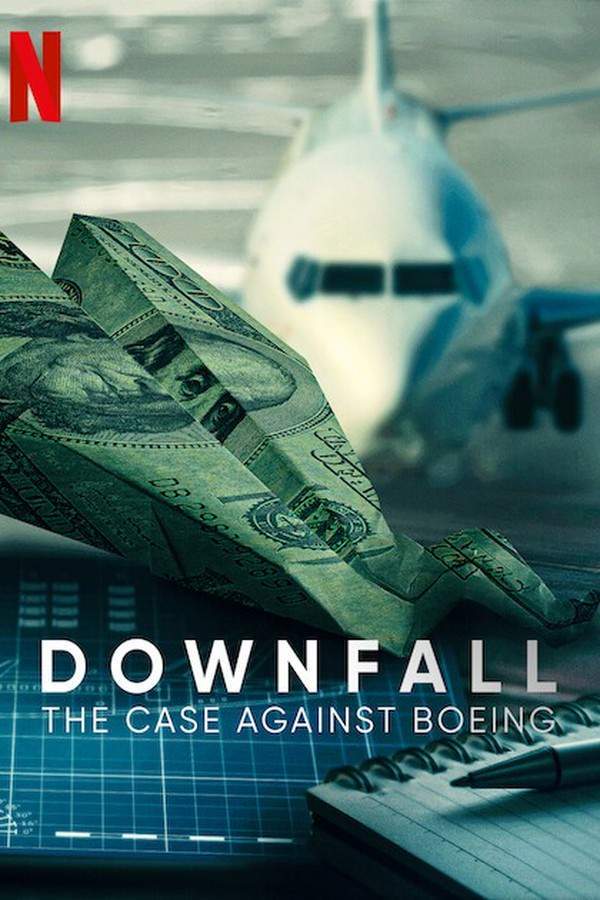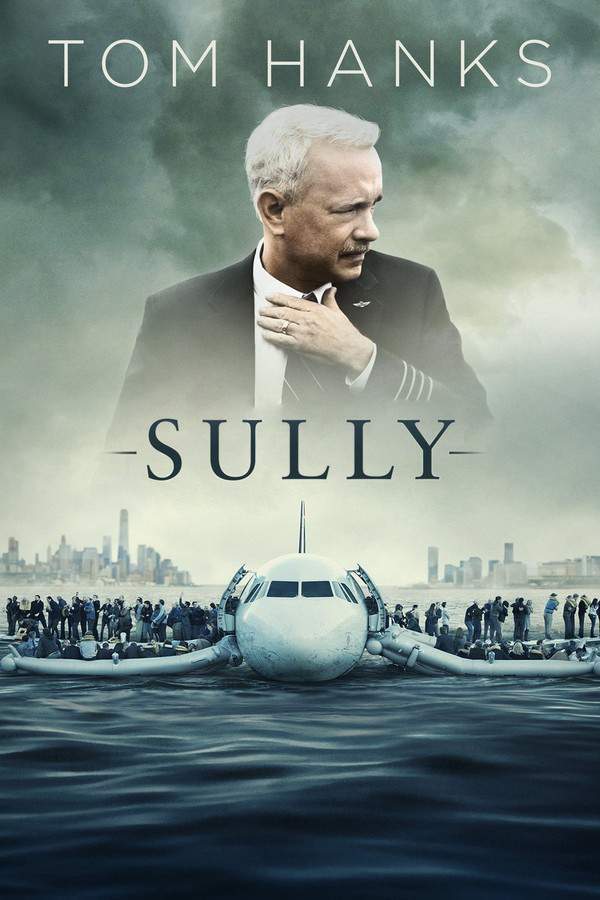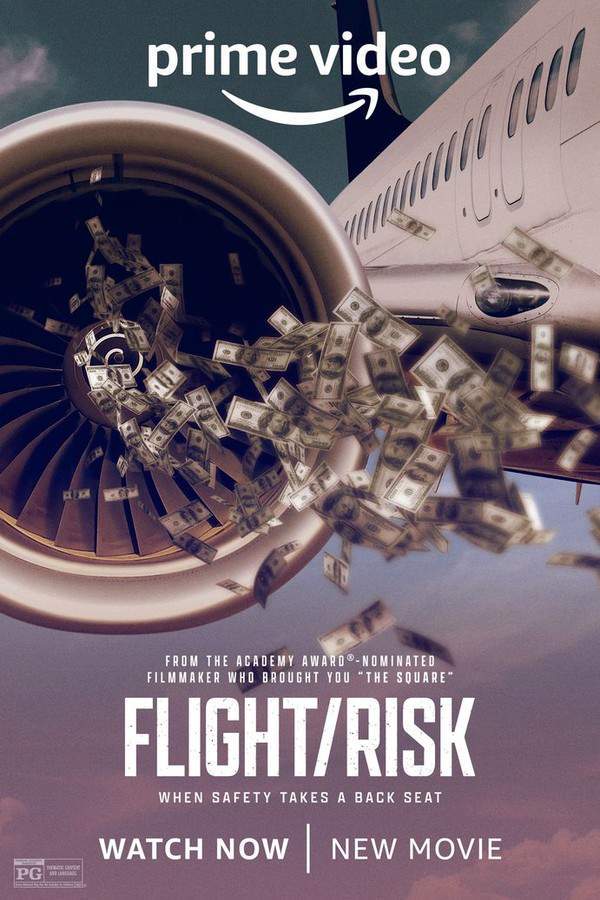Downfall: The Case Against Boeing 2022

This documentary examines the events surrounding two tragic accidents involving Boeing 737 MAX airplanes, exploring the factors that led to the disasters and the aftermath for the victims’ families. It investigates the design flaws, corporate decisions, and regulatory oversight that contributed to the crashes, raising critical questions about accountability and the safety of modern aviation.
Does Downfall: The Case Against Boeing have end credit scenes?
No!
Downfall: The Case Against Boeing does not have end credit scenes. You can leave when the credits roll.
Meet the Full Cast and Actors of Downfall: The Case Against Boeing
Explore the complete cast of Downfall: The Case Against Boeing, including both lead and supporting actors. Learn who plays each character, discover their past roles and achievements, and find out what makes this ensemble cast stand out in the world of film and television.
No actors found
External Links and Streaming Options
Discover where to watch Downfall: The Case Against Boeing online, including streaming platforms, rental options, and official sources. Compare reviews, ratings, and in-depth movie information across sites like IMDb, TMDb, Wikipedia or Rotten Tomatoes.
Ratings and Reviews for Downfall: The Case Against Boeing
See how Downfall: The Case Against Boeing is rated across major platforms like IMDb, Metacritic, and TMDb. Compare audience scores and critic reviews to understand where Downfall: The Case Against Boeing stands among top-rated movies in its genre.

The Movie Echo Score
Downfall: The Case Against Boeing presents a clear, fact‑driven indictment of Boeing’s profit‑first culture, coupling technical detail with emotionally resonant testimonies. Critics note its swift pacing and academic precision, while users praise its heartbreaking impact and informative depth. Some reviewers criticize its reliance on talking‑head interviews and limited cinematic flair, but the consensus is that the film succeeds in exposing systemic failures without sacrificing clarity. Overall, the documentary is judged solidly effective and emotionally powerful.
The Movie Echo Score Breakdown for Downfall: The Case Against Boeing

Art & Craft
The documentary’s art and craft are competent but unremarkable. Critics commend its swift, clear editing and occasional visual potency, yet label it an average talking‑head format with limited cinematic ambition. Viewers acknowledge balanced editing but point out low‑budget CGI and conventional visual style. Consequently, the film achieves functional craftsmanship without notable artistic distinction.

Character & Emotion
Character and emotional resonance are the film’s strongest assets. Critics highlight the power of parent and widower testimonies, and users describe the narrative as heartbreaking and deeply moving. While the documentary format limits character development, the emotional testimonies provide nuanced human context. This blend of personal stories and factual reporting yields a compelling emotional core.

Story & Flow
The story’s structure is clear and purposeful, delivering a solid indictment of corporate greed. Critics mention its swift pacing and logical flow, though some find it conventional and lacking narrative innovation. Users note occasional confusing passages but appreciate the overall coherence. The film maintains a measured pace that supports its investigative aims without becoming overly complex.

Sensory Experience
Sensory elements are functional yet modest. Reviewers praise clear visual presentation but criticize the reliance on talking‑head shots and subpar CGI recreations. Sound design and music are not prominently highlighted, resulting in a restrained auditory experience. The documentary’s sensory design serves the informational content but does not elevate the viewing experience.

Rewatch Factor
Rewatch value is moderate, anchored by its emotional impact and informative content. Critics find the film effective and enraging, encouraging repeat viewings for its factual depth. Users describe it as emotionally resonant yet not exhausting, suggesting it can be revisited for insight. While the documentary’s style may limit long‑term novelty, its substantive material sustains interest on subsequent viewings.

68
Metascore
7.7
User Score


91%
TOMATOMETER

90%
User Score

7.4 /10
IMDb Rating

71
%
User Score

3.4
From 4 fan ratings

5.00/5
From 2 fan ratings
Take the Ultimate Downfall: The Case Against Boeing Movie Quiz
Challenge your knowledge of Downfall: The Case Against Boeing with this fun and interactive movie quiz. Test yourself on key plot points, iconic characters, hidden details, and memorable moments to see how well you really know the film.
Downfall: The Case Against Boeing Quiz: Test your knowledge about the Boeing 737 MAX tragedies and the controversial practices in the aviation industry as depicted in "Downfall: The Case Against Boeing."
What tragic event is central to the film's narrative?
The construction of a new Boeing headquarters
The crashes of two Boeing 737 MAX airliners
The merger of Boeing and McDonnell Douglas
The launch of a new Boeing aircraft model
Show hint
Awards & Nominations for Downfall: The Case Against Boeing
Discover all the awards and nominations received by Downfall: The Case Against Boeing, from Oscars to film festival honors. Learn how Downfall: The Case Against Boeing and its cast and crew have been recognized by critics and the industry alike.
77th Academy Awards 2005
Foreign Language Film
Full Plot Summary and Ending Explained for Downfall: The Case Against Boeing
Read the complete plot summary of Downfall: The Case Against Boeing, including all major events, twists, and the full ending explained in detail. Explore key characters, themes, hidden meanings, and everything you need to understand the story from beginning to end.
The film delves into the devastating incidents involving the Boeing 737 MAX in 2019, which led to the tragic crashes of two airliners and the loss of 346 lives. At the core of the narrative is a critical examination of whether Boeing prioritized financial profits over the safety of its passengers and the company’s longstanding reputation for quality and safety.
As Kennedy articulated about Boeing’s journey into the 21st century, > “There were many decades when Boeing did extraordinary things by focusing on excellence and safety and ingenuity. Those three virtues were seen as the key to profit.” However, this focus began to shift when the company was taken over by leaders who viewed Wall Street as the ultimate objective, rather than balancing profit with public welfare.
The story follows the events from October 19, 2018, when LionAir Flight 610 tragically plummeted shortly after takeoff in Jakarta, Indonesia. The Boeing 737 MAX, newly introduced yet untested, was thought to be in normal ascent; however, faulty sensor readings caused the aircraft to lose control, crashing and claiming 189 lives. Initially, Boeing deflected blame onto the Indonesian air safety standards, LionAir, and pilot errors, never acknowledging the possibility of a flaw in their aircraft design.
As recovery efforts continued, black box findings revealed that a defective angle of attack sensor had triggered erroneous readings, leading to repeated nose-down commands from the plane’s Maneuver Characteristics Augmentation System (MCAS). Despite the mounting evidence, Dennis Muilenburg, then Chairman of Boeing, maintained a public facade of safety, downplaying the system’s role.
In November, Boeing released a statement about the erroneous MCAS activation, a term that had been previously unknown to many, including the pilots of Lion Air. Critics, including journalist Andy Pasztor from the Wall Street Journal, contended that Boeing withheld vital information regarding the MCAS from pilot unions, igniting a firestorm within the aviation community. Following the LionAir crash, Boeing began to brief pilot unions about the system’s implications, while simultaneously reassuring the public of the 737 MAX’s safety.
Then, on March 10, 2019, tragedy struck again as Ethiopian Airlines Flight 302 met a similar fate, killing 157 individuals. This time, investigators discovered almost identical patterns to the LionAir incident. The swift grounding of the aircraft by Trump and subsequent congressional investigations highlighted the growing concern regarding pilot training and design flaws within Boeing’s operations.
For years, Boeing had been celebrated as a titan in the aviation industry, known for its innovations such as the Boeing 707 and 747; however, a shift toward prioritizing profit led to diminished safety protocols. The pivotal merger with McDonnell Douglas in 1996 under Harry Stonecipher brought about a culture where cutting costs took precedence over engineering excellence.
As production pressures intensified, a reduction in quality staff and resources became apparent. By the time the 737 MAX was introduced, the plants were primarily focused on rapid output, hampering Boeing’s commitment to safety and quality. With Airbus gaining ground in the market and the A320 NEO launching successfully, Boeing sought to modify the aging 737 design by adding new fuel-efficient engines without inciting the need for retraining pilots. However, this plan led to a reliance on a single sensor for critical flight operations—an oversight that would later prove catastrophic.
In a series of congressional hearings, it became evident that Boeing was aware of the potential risks yet chose to pursue profit over rigorous safety protocols. The fallout from the investigations resulted in Boeing facing severe financial penalties, leading to a corporate re-evaluation. Ultimately, the MCAS system was redesigned, and the grounded fleet recommenced operations in November 2020.
Boeing’s journey through these crises shines a light on the critical importance of safety in aviation, the devastating outcomes of neglecting this principle, and raises questions about corporate responsibility and ethics in high-stakes industries.
Uncover the Details: Timeline, Characters, Themes, and Beyond!

Coming soon on iOS and Android
The Plot Explained Mobile App
From blockbusters to hidden gems — dive into movie stories anytime, anywhere. Save your favorites, discover plots faster, and never miss a twist again.
Sign up to be the first to know when we launch. Your email stays private — always.
Watch Trailers, Clips & Behind-the-Scenes for Downfall: The Case Against Boeing
Watch official trailers, exclusive clips, cast interviews, and behind-the-scenes footage from Downfall: The Case Against Boeing. Dive deeper into the making of the film, its standout moments, and key production insights.
Downfall: The Case Against Boeing Themes and Keywords
Discover the central themes, ideas, and keywords that define the movie’s story, tone, and message. Analyze the film’s deeper meanings, genre influences, and recurring concepts.
Downfall: The Case Against Boeing Other Names and Titles
Explore the various alternative titles, translations, and other names used for Downfall: The Case Against Boeing across different regions and languages. Understand how the film is marketed and recognized worldwide.
Similar Movies To Downfall: The Case Against Boeing You Should Know About
Browse a curated list of movies similar in genre, tone, characters, or story structure. Discover new titles like the one you're watching, perfect for fans of related plots, vibes, or cinematic styles.
Quick Links: Summary, Cast, Ratings, More

What's After the Movie?
Not sure whether to stay after the credits? Find out!
Explore Our Movie Platform
New Movie Releases (2025)
Famous Movie Actors
Top Film Production Studios
Movie Plot Summaries & Endings
Major Movie Awards & Winners
Best Concert Films & Music Documentaries
Movie Collections and Curated Lists
© 2025 What's After the Movie. All rights reserved.































